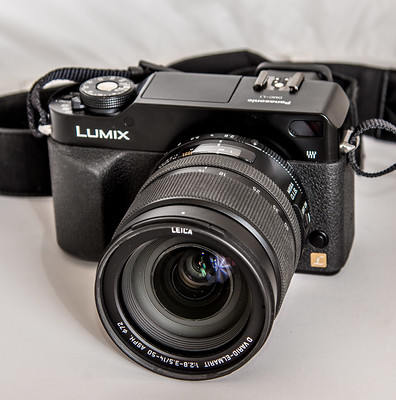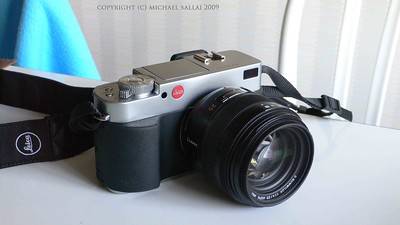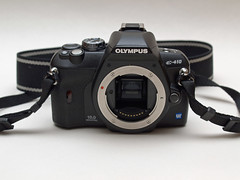Four Thirds

|
| Olympus E-500 image by Tim Williams (Image rights) |
Four Thirds is a photographic system, similar in concept to Olympus’ OM system for film photography. The name ‘Four-Thirds’ derives from the size and format of the image sensor used in the camera bodies. The system was developed by Olympus in partnership with Kodak and several other photographic companies have also signed up to it to produce lenses, cameras and accessories to the same standard. These companies include Panasonic, Sigma, Fujifilm and Leica.
Four Thirds is not an open standard; Olympus controls access to the design specifications and no unauthorised third-party companies are able to use the Four Thirds logo or create supported peripherals for the system.
Image Sensor
Unlike 35mm film (and therefore most APS-C sized sensors used by other big camera brands such as Nikon, Canon or Pentax) the Four Thirds system uses a ratio of 4:3 for its image sensor — 35mm film has a ratio of 3:2 (whereby the long edge of the rectangular sensor is either 4/3rds or 3/2 the length of the shorter side). This ratio was inherited from analogue TV standards.
The actual size of the 4/3 sensor — specified by Olympus, and a design constant in the 4/3rds system white paper — is 18mm × 13.5mm, with an imaging area of 17.3mm × 13.0mm. This gives the image a diagonal length of 21.6mm; the smallest of the common APS-C sensors used has a diagonal of 24.88mm with dimensions of 20.7mm × 13.8 mm.

|
| Panasonic Lumix DMC-L1 image by maoby (Image rights) |
The diagonal length of the 4/3rds sensor is roughly half that of a 35mm film negative. The Four-Thirds system has been criticised for the small size of its sensor, but the sensor size is only slightly smaller than the popular entry-level DSLR, the Canon EOS 400D. At 4.2µm, the pixel pitch of an Olympus E-30 12MP sensor is identical to that of the Canon EOS 7D 18MP sensor.
Unlike other systems however, Four-Thirds cameras have the only sensor size optimized for digital. All Four-Thirds compliant lenses produce a telecentric image circle, resulting in photos that are virtually free from chromatic aberrations, vignetting or diffraction. While other systems emphasize the compatibility of their digital bodies with their legacy lenses from the film era, Olympus chose to start from scratch with a new system optimized for the optical needs of digital sensors. Unlike film, digital sensors require light to fall perpendicularly to avoid optical distortions. As a result, all Four Thirds lenses out-resolve in optical terms their competitors in the equivalent focal lengths.
The ratio of the image size, combined with the smaller sensor means that Four-Thirds based DSLRs have a 'crop factor' of exactly 2 — that is to say, a 50mm film lens used on a Four-Thirds body gives the equivalent field of view to a 100mm lens on a 35mm film camera body. The term 'crop factor' is somewhat misleading as the sensor does not crop the image at all — it simply utilises a smaller section of the lens. In essence only the portion of light entering the lens that actually hits the sensor is altered, meaning the field of view is smaller, and thereby effectively doubling the focal length of the lens.
The 'crop factor' does affect the apparent depth of field of the taken image: with the magnification of 2, the DOF is effectively doubled (again, it is important to note that this perceived effect is due to the FOV 'crop'; the same depth of field is present, but you are viewing it at twice the magnification).
It is important to note that neither the light gathering ability of the lens, nor any of its traits are actually affected: a 50mm f2 lens on a 4/3rds body has the same f-stop as a 50mm lens on a 35mm camera. But the 4/3rds sensor only records the equivalent field of view of a 100mm lens.
As a general rule of thumb the depth of field of a lens is halved as its focal length is doubled (if the aperture remains constant). The end result is therefore that a 4/3rds camera has twice the depth of field as a 35mm camera with a lens covering the same field of view.
Returning to the above example, the depth of field produced by a 50mm f/2 OM lens used on a 4/3rds digital body is effectively equal to a 35mm camera with a 100mm lens set at f/4.
As a further example of the above, let us compare a 35mm camera and a 4/3rds camera in a given situation:
- 35mm: 100mm lens, f/4, ISO 800, 1/200sec
- 4/3rds: 50mm lens, f/2, ISO 200 1/200sec
Using the same shutter speed, both these cameras would have the same exposure, have the same depth of field, and the same field of view. But the smaller sensor size of the 4/3rds requires a lower ISO to be used at the same shutter speed - so the doubling of the depth of field necessitates a two-stop compensation in sensitivity for the same end result.
This allows a photographer to either use a lens at a lower F-stop (for faster shutter speeds) or shoot at a lower ISO (for lower noise in the final image) than would be possible in 35mm or APS-C format. Olympus states this field of view/depth of field effect was a primary consideration in the design of the Four-Thirds system.
Lenses

|
| Lumix L1 clone Leica Digilux 3 with Leica lens type Summilux image by El Don Quijote (Image rights) |
Main article: Four-Thirds lenses
The principles outlined above in the design of the 4/3rds sensor also follow into the lens designs for the system: with a crop (or magnification) factor of 2, a telephoto lens for the 4/3rds system with the same field of view that of a lens designed for 35mm can be half the size.
For example, a 150mm lens fitted to a 4/3rds body produces the same field of view (and therefore effectively the same magnification) as a 300mm lens on a 35mm film camera. Not only does this mean 4/3rds lenses can be half the size of their 35mm counterparts, it also means it is much easier and cheaper to produce lenses with good focal length to f-stop ratios.
Most 4/3rds lenses are also telecentric, meaning that no matter what angle the light enters the lens, the glass within the lens is designed to ensure the beams of light hit the sensor straight on. This design requirement is due to the nature of digital sensors: they are highly sensitive to the angle at which light hits them, with highly angled photons not being picked up by the sensor at all.
The lens mount for 4/3rds is roughly twice that of the imaging sensor, again allowing improvements in lens design: with the lens focusing the image down to half the area before it hits the sensor, it allows the lenses to be brighter without sacrificing the size or weight advantages gained by the smaller sensor.
Information on 4/3rds mount lenses is listed on the Four-Thirds lenses page.
Camera Bodies
To date, three companies have produced camera bodies compatible with the Four-Thirds system:
Olympus
All Olympus’ DSLR bodies conform exactly to the Four-Thirds specifications. As of July 2007, all of the current models will also feature ‘Live-View’, a feature which allows the camera to use the rear LCD display in a similar way to that used on compact digital cameras — showing a live display of the image being processed by the sensor. The latest bodies (E-420/E-520 and newer) use Olympus' most advanced form of Live-View which allows contrast detection autofocus, up to 10x magnification for manual focus, depth of field preview and exposure compensation preview.
All Olympus DSLR bodies also feature a patented 'Supersonic Wave Filter' dust removal system, which shakes a thin layer in front of the sensor using ultrasonic frequencies. This method of cleaning was first released into the market by Olympus, and reportedly remains the only truly successfully implemented anti-dust solution.
As befits the 4/3rds philosophy of small and light lenses, all Olympus' camera bodies are comparatively lightweight. The E-500 was the smallest and lightest DSLR at the time of its release; an accolade it recently lost to another Olympus camera range: the new Olympus E-400 series.

|
| image by Michael Gatchell (Image rights) |
- Olympus E-1
- Olympus E-3
- Olympus E-30
- Olympus E-300 (EVOLT E-300)
- Olympus E-330 (EVOLT E-330)
- Olympus E-400
- Olympus E-410
- Olympus E-420
- Olympus E-450
- Olympus E-5
- Olympus E-500 (EVOLT E-500)
- Olympus E-510
- Olympus E-520
- Olympus E-600
- Olympus E-620

|
| image by arresembasaitus (Image rights) |
Panasonic
Panasonic have released two cameras for the Four-Thirds system, both of which come as kits coupled with Leica-badged, Panasonic-built optically stabilised lenses. The L-1 is designed to look like a Leica rangefinder styled camera (and in fact Leica later released a re-badged version of this camera naming it the Leica Digilux 3) whereas the L-10 is a DSLR variant of their Lumix FZ range (very similar in styling to the FZ-30, though obviously with inter-changeable lenses). The L-10 brought the Four-Thirds concept of ‘Live-View’ further by being the first with the ability to use contrast detection autofocus off the sensor (with specific lenses).
- Panasonic Lumix DMC-L1
- Panasonic Lumix DMC-L10
Leica
As well as releasing several lenses for the Four-Thirds system, Leica released a re-badged version of Panasonic’s DMC-L1 for the Four-Thirds system.
Links
- Four-Thirds Website
- Andrzej Wrotniak’s page devoted to Olympus’ 4/3rds ‘E’ System cameras
- US6910814, Original US patent for the 4/3rds system
- Pixinfo.com Dust Removal System Tests (archived)
- FourThirds Photo — The unofficial community for the system (archived)
- DXO Camera Comparison of the Olympus E-30 vs Canon EOS 7D